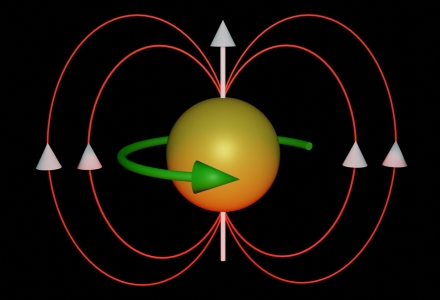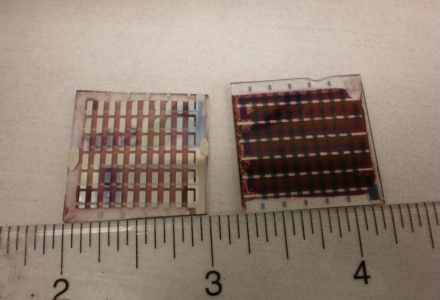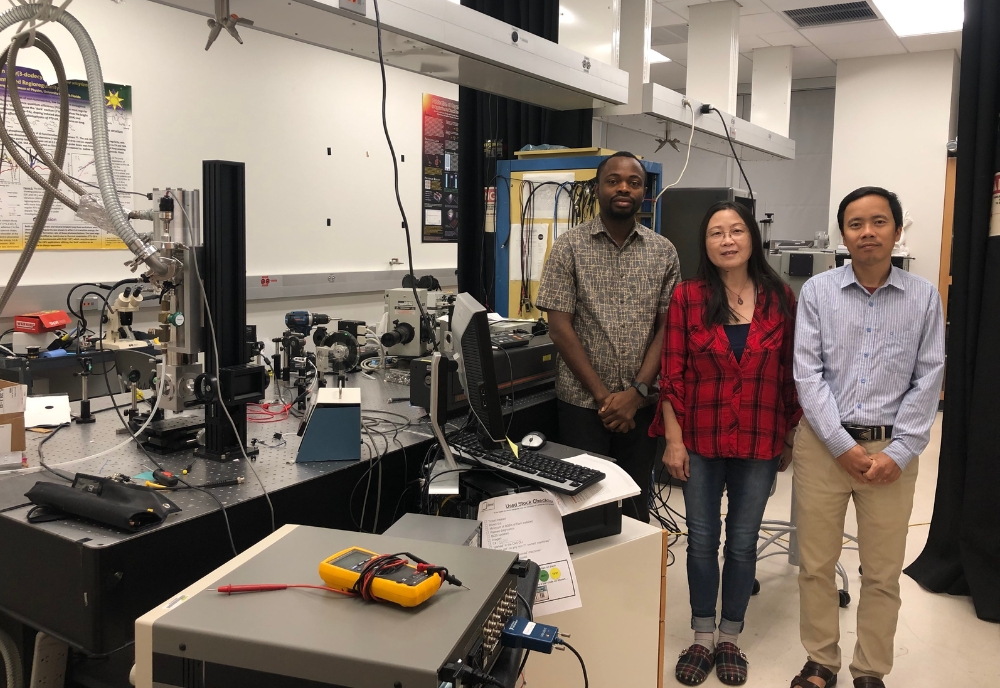Dr. Xiaomei Jiang, associate professor in the Department of Physics, is a dedicated researcher in the field of spintronics. Spintronics is the study and use of the spin of electrons and holes to create faster and more efficient electronic devices. The goal of spintronic devices is to harness and manipulate electron spin to enhance data computing performance compared to conventional electronics.

A depiction of spintronic arrows rotating around a sphere. (Photo source: Adobe Stock)
Her most recent research project aims to understand how two-dimensional hybrid organic inorganic perovskites multiple quantum wells (2D-MQW) can be used to create cost-effective spintronic devices. The current choice of materials are metal halide perovskites, which are a group of materials with promising capabilities for efficient and cost-effective optoelectronic devices including solar cells, photoconductors, and light emitting diodes. Solar cells are devices that convert sunlight into electricity using semiconductors. Part of Jiang’s research is to better understand this material and provide a guide to other researchers.
“Through the research, we work to optically, electrically, and magnetically probe and manipulate the spins in 2D-MQW. We hope to gain a fundamental understanding of spin degree of freedom in these materials. This knowledge will help to develop guidelines for material synthesis and device engineering for efficient and cost-effective spintronic devices,” Jiang said.
Jiang is collaborating with postdoctoral researcher Dr. Xuan Chung Nguyen and two graduate students, Emmanuel Olawale and Elnaz Jaberolansar on this project. They have secured $480,000 in funding from the National Science Foundation’s Division Materials Research – Electronics, Photonics, and Magnetic Devices to fund this endeavor.
Although this project is ongoing, notable progress has been made. The team successfully synthesized and characterized the 2D-MQW and its magnetic properties. They have made an intriguing discovery regarding the excitons, which are neutral particles involved in carrying electrical charge when light interacts with specific materials. These excitons can generate a spin photocurrent, which is an electric current influenced by the spinning motion of electrons under circularly polarized light exposure.
Jiang and her team are continuing their investigation into this phenomenon, exploring the potential physical mechanisms that may be responsible for it. She highlights the significance of this research by explaining how it could lead to the development of more energy-efficient methods for storing data and advancing computing technologies.

An organic micro solar array, developed in a previous study by Dr. Xiaomei Jiang, intended for use in microelectromechanical systems. (Photo courtesy of Dr. Xiaomei Jiang)
“Hybrid metal halide perovskites have emerged as a promising class of semiconductors with device applications in solar cells. These materials also have large spin-orbit coupling, which makes these perovskites a candidate for spintronic devices. These devices will enable novel technologies such as energy efficient devices for data storage or advanced computing,” Jiang explained.
“Spintronic devices are currently made from quantum wells comprising of alternating layers of inorganic semiconductors. These structures are expensive to make, contrary to a two-dimensional hybrid perovskite that consists of alternating organic and inorganic layers which can be fabricated at a low-cost. Although perovskites meet several important prerequisites for viable spintronic devices, there is lack of fundamental understanding of the spin-related phenomena in this new material,” she said.
In the future, Jiang aims to contribute to the field of spintronics and provide insights for scientists working in this area. She also intends to collaborate with the Department of Chemistry to develop a new class of lead-free low-dimensional chiral perovskites for future spintronics research.
To learn more about Dr. Xiaomei Jiang’s work, please visit the website for the Department of Physics.
